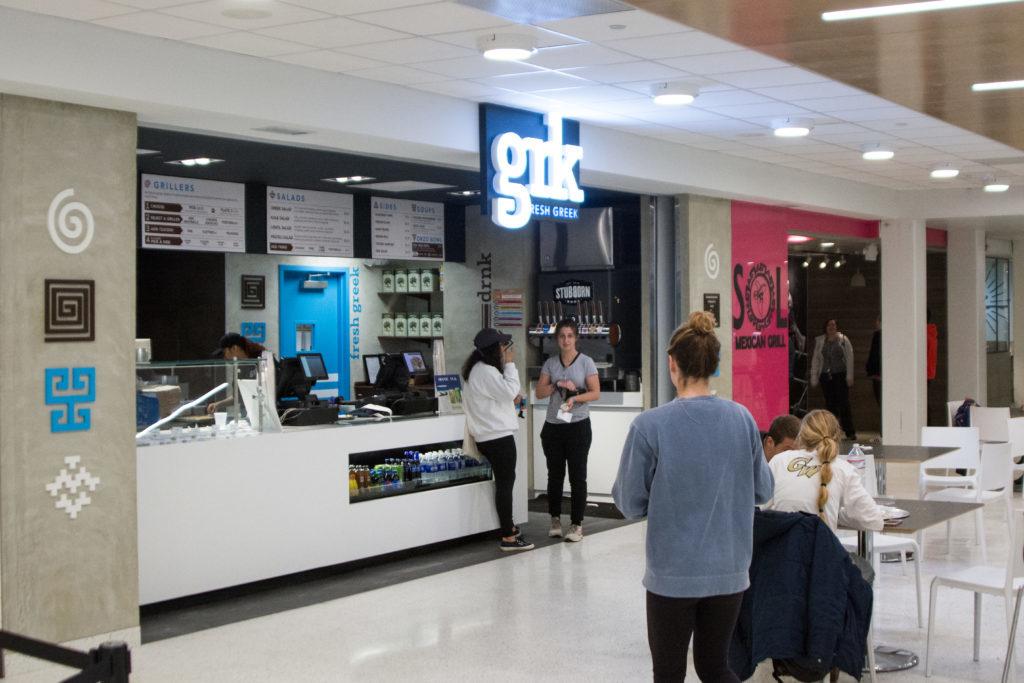University leaders say they are still on track to have 20 percent of all food on campus qualify as “real food” by 2020 by encouraging campus vendors to use local and sustainable food.
The University uses nearly 10 percent real food in its dining services as part of the Real Food Challenge, a program that works with university leaders nationwide to shift food budgets toward more sustainable, organic or local options, officials said. Experts say GW’s vendor-heavy dining plan could present roadblocks in reaching the goal because the University doesn’t have much control over their policies.
Meghan Chapple, the director of the Office of Sustainability, said by the end of fiscal year 2015, the University was using 9.7 percent local and sustainable food that complied with the challenge.
University President Steven Knapp said when GW joined the challenge in 2014 that at least 20 percent of the food coming from GW’s dining halls would qualify as local and sustainable by 2020. This goal initially included food served at the J Street dining hall, which closed last year. Pelham Commons on the Mount Vernon Campus is now the only University-run dining hall.
Chapple said J Street’s closing hasn’t impacted the University’s involvement in the program because Restaurant Associates, GW’s new catering provider, signed the same transparency agreement with the Real Food Challenge.
“We have implemented the same sustainable practices used at J Street across all of our remaining on-campus dining options,” Chapple said.
She added that the University uses compostable and recyclable flatware, purchases local produce and seafood and tries to limit food waste in kitchens.
Tlaloc Vasquez, the northeast regional coordinator for the Real Food Challenge, said that even without an official dining hall, a university could still participate in the program by asking third-party vendors to serve sustainable food.
“I could see the University making space and prioritizing vendors that do sell real food and that use local products and that are community based,” Vasquez said. “If this is the McDonald’s and Taco Bells of the world, I don’t think they’ll come close to meeting that number or that range or those priorities.”
For GW to provide students with “real food,” the vendors would need to sell food that is local, humanely sourced, organic or ecologically sound and fair trade, Vasquez said. That could be challenging for vendors who do not share a commitment to sustainable food, he said.
Representatives from recently opened vendors in District House, like Chick-fil-A and GRK Fresh Greek, said they include sustainable options by sourcing food locally and using compostable or recyclable flatware and biodegradable packaging – all actions that would count toward the University’s goal.
Eric Robinson, a manager at Chick-fil-A, said the company already purchases local food, even without the challenge.
“All our produce comes from right here in Maryland,” Robinson said. “As a company, we purchase from sustainable vendors.”
Alex Alevras, a manager at GRK Fresh Greek, said University officials have emphasized using sustainable food, and that the restaurant purchases food locally.
“We source locally as much as we can,” Alevras said.
Management staff at Peet’s Coffee and Beef & Bread said they didn’t know GW was partnered with the Real Food Challenge.
Although all six planned restaurants in District House are now open, members of sustainably minded student organizations said campus’s healthier options, like Whole Foods and Sweetgreen, are too expensive.
Logan Malik, the chair of the SA’s student life committee, said that although GW’s meal plan allows students to use their dining dollars at establishments that sell local and sustainable food, like Whole Foods and Sweetgreen, it can be difficult for some students to afford.
“There are a lot of problems with the fact that there’s no dining hall,” Malik said. “There’s nothing that shows you what your choices are, and shows students, ‘this is your healthy option.’”





